Published 29 NOV 2024
Gereon Krebber
Lagelagelage
15 NOV until 20 DEC 2024
The gallery alexander levy is pleased to present the exhibition Lagelagelage by Gereon Krebber.
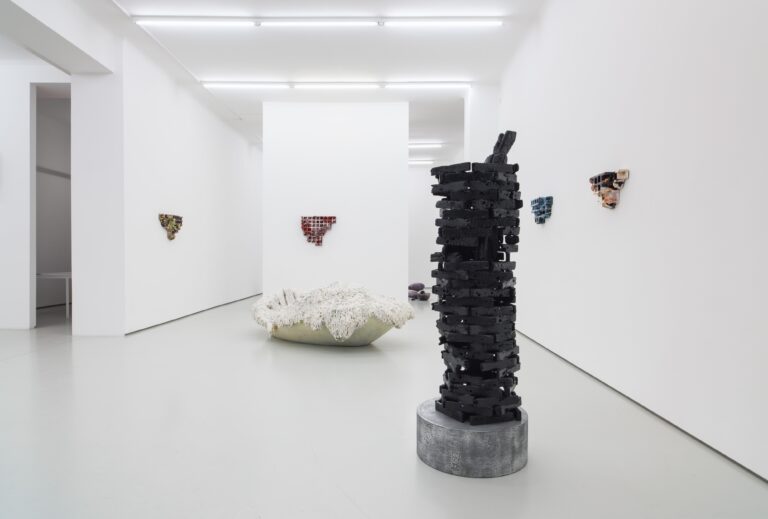
Gereon Krebber, Lagelagelage, installation view, alexander levy, Berlin,
courtesy of the artist and alexander levy, Berlin,
photo: Marcus Schneider
Lagelagelage picks up on the well-known real estate slogan, location location location, in order to encapsulate Krebber’s fascination with the tension between stable construction and delicate fragility. The works reference large cities characterized by construction projects and real estate speculation which present our societies with social segregation and exclusion amid a globalized landscape. Our urban environment is built on geometric and symmetric construction materials – structures that are disrupted and have their symmetry dissolved in the exhibition. Lagelagelage consciously plays with imagery of situations of upheaval, precarious phases and disintegrating structures, as they often appear in an urban context.
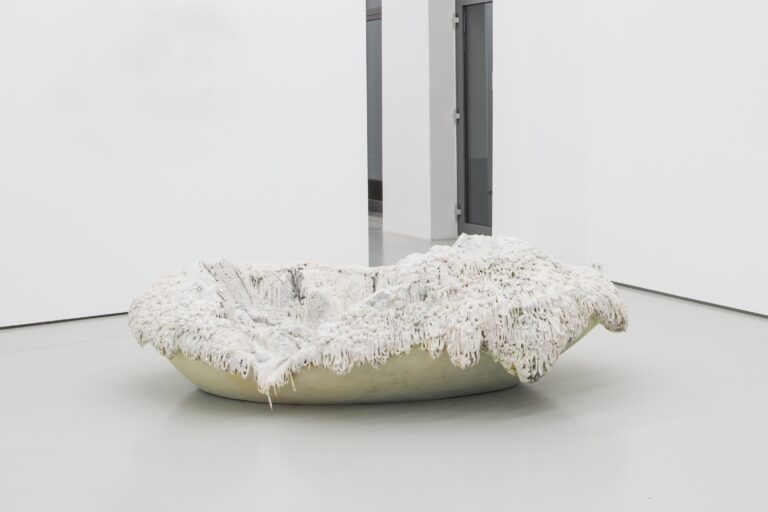
Gereon Krebber, Bonus (Disrupted), 2008-2024, acrylic resin, polyurethane, polystyrene, paint, 79 x 250 x 128 cm,
courtesy of the artist and alexander levy, Berlin,
photo: Marcus Schneider
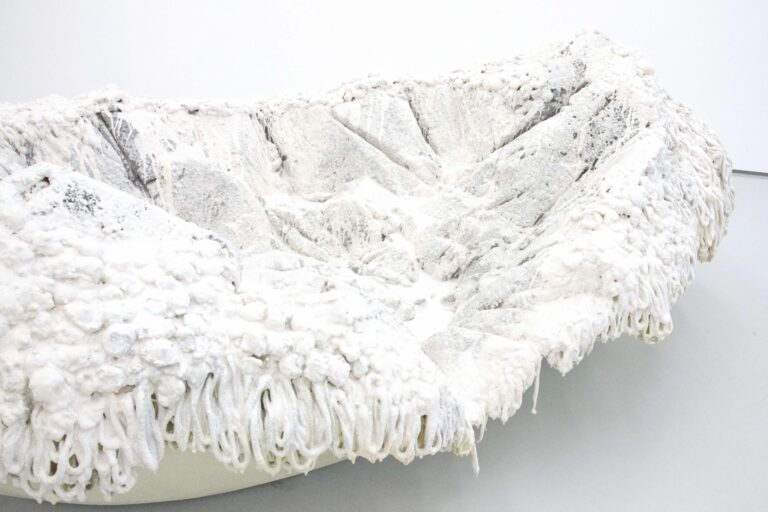
Gereon Krebber, Bonus (Disrupted), 2008-2024, acrylic resin, polyurethane, polystyrene, paint, 79 x 250 x 128 cm,
courtesy of the artist and alexander levy, Berlin,
photo: Marcus Schneider
The sculptures made of ceramics, polyurethane, concrete and metal are evocative of defamiliarized versions of furniture: whether shelf or playground scaffolding, bathtub or electrical switch box – the utilitarian objects are removed from their initial purpose and have taken on a life of their own. The exhibition combines individual work groups that engender an impression of an abstract, chaotic cityscape in the gallery. The state between stability and fragility becomes tangible here – the tension between monumental buildings and the precarious reality of urban living space.
On entering, visitors encounter a bathtub in tones of white made of construction foam that overflows along the edges while at the same time showing a gaping opening in the middle – roughly cut out like an improvised theater prop. Bonus (Disrupted) is a sculpture from 2008 Krebber has reworked. The fluffy, uniform foam bath has become a cratered landscape, the soft material appears petrified.
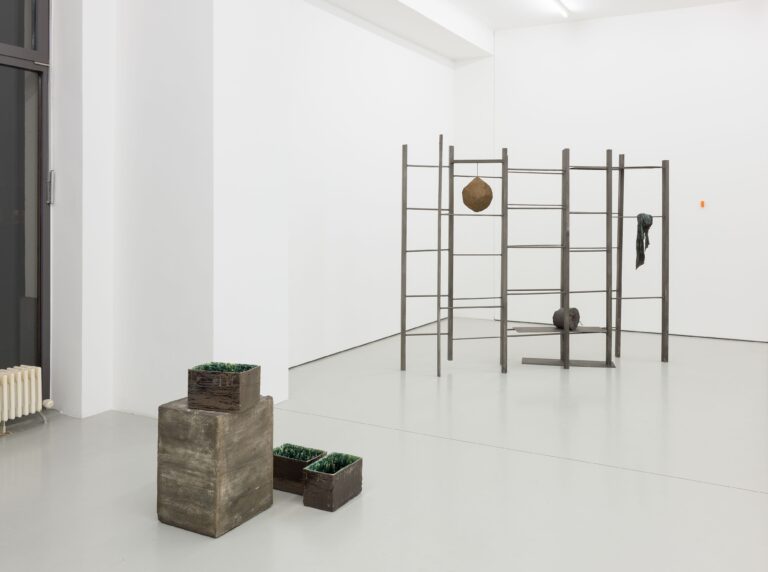
Gereon Krebber, Lagelagelage, installation view, alexander levy, Berlin,
courtesy of the artist and alexander levy, Berlin,
photo: Marcus Schneider
The Dupperbox, a sculpture made of glazed ceramic, stands on the edge of a concrete plinth, its position is unstable. The fragile sculpture at rist of falling and shattering. The moment of tipping seems frozen and makes the impending imbalance tangible.
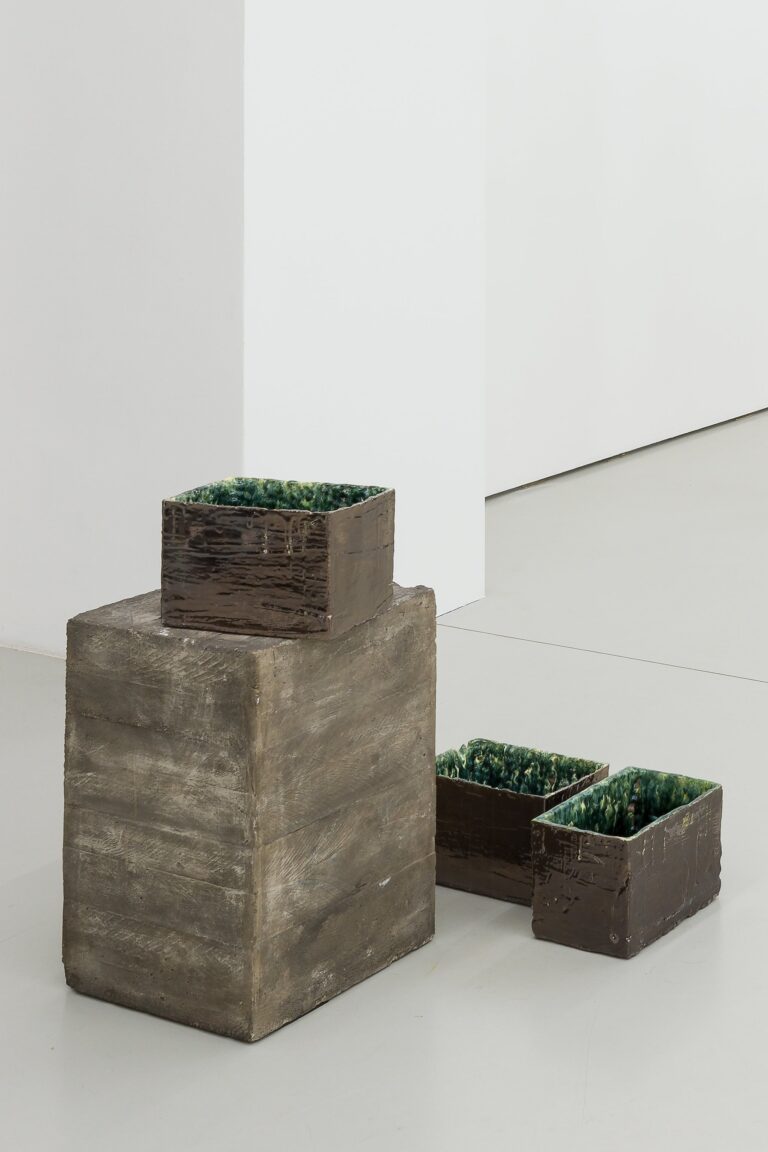
Gereon Krebber, Dupperbox Triple (Kupfergrün) Vs. Concrete Block, 2023-2024, glazed ceramics, concrete plinth, dimensions variable,
courtesy of the artist and alexander levy, Berlin,
photo: Marcus Schneider
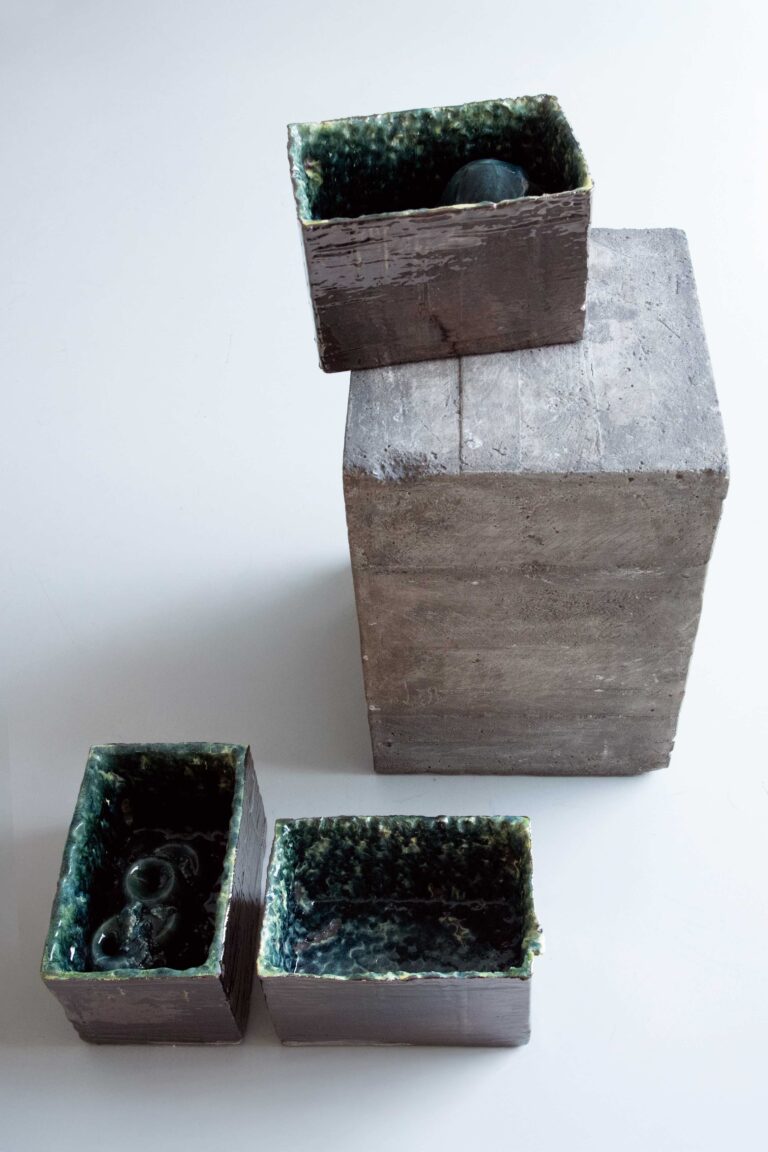
Gereon Krebber, Dupperbox Triple (Kupfergrün) Vs. Concrete Block, 2023-2024, glazed ceramics, concrete plinth, dimensions variable,
courtesy of the artist and alexander levy, Berlin,
photo: Marcus Schneider
The gray steel frame What if we were wrong is reminiscent of a structure for a shelf, a scaffolding frame of a defunct playground or a dilapidated building: crooked, broken and devoid of all form except for a few remnants such as a swollen rag and a concrete weight. A bronze-colored object is suspended in the structure like a crystal moon, instilling a sense of expectation that construction will one day resume. The work evokes melancholy, reminiscent of projects in major cities that are started but forgotten for years – delicate, fragmentary and abandoned. Behind it is a minuscule orange glimmer of hope – Früchtchenblock is a rather small ceramic work building a bridge to the adjacent exhibition “Miniatures” by Friedrich Einhoff and Max Neumann.
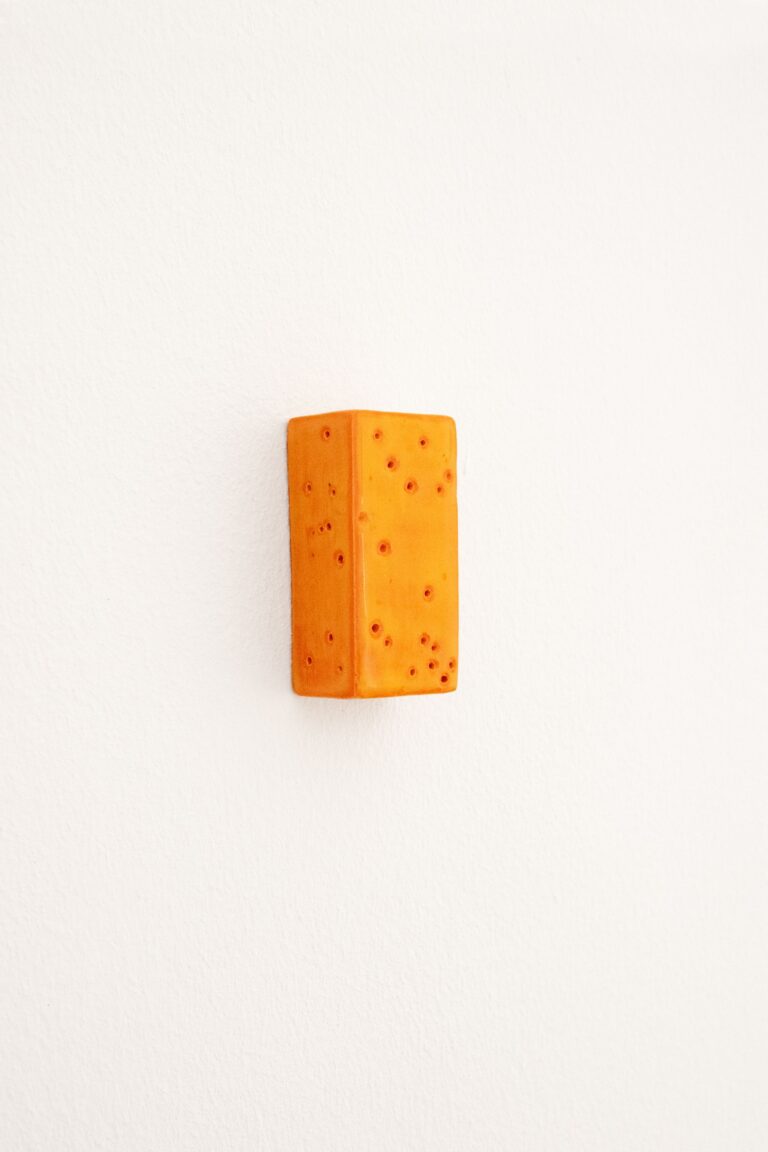
Gereon Krebber, Früchtchenblock (Micks Orangegelb), 2023, glazed ceramic, 7 x 3,3 x 2,8 cm,
courtesy of the artist and alexander levy, Berlin,
photo: Marcus Schneider
Hanging on the walls are works from the Kompartimento series, which look like scaled pieces of rubble. They are artificial fragments modeled using ceramics with a strictly rectangular, uniform structure, symbols of modern architecture. Deliberately broken and deformed, they appear partially destroyed. The fragments are arranged horizontally like hanging trophies or evidence of urban architecture. They are covered with luminous glazes which seem to flow over the fragments just like saliva or fruit jelly, contrasting with the austere formal elements. The sculpture Jengo refers to the well-known game with towers made of wooden sticks: an oversized wobbly pile of charred pieces of wood stands on a round plinth, and although this foundation provides it with a stable base, it nevertheless remains fragile. If one too many piece is taken out, the tower will collapse. The magnified, charred version of the game evokes the temporary, precarious nature of urban constructions.
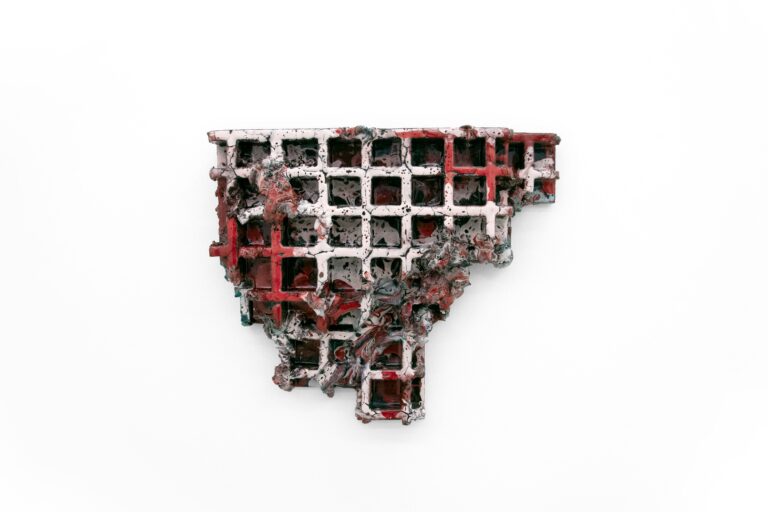
Gereon Krebber, Reddo (Kompartimento), 2024, glazed ceramic, 52,5 x 64,5 x 18,2 cm,
courtesy of the artist and alexander levy, Berlin,
photo: Marcus Schneider
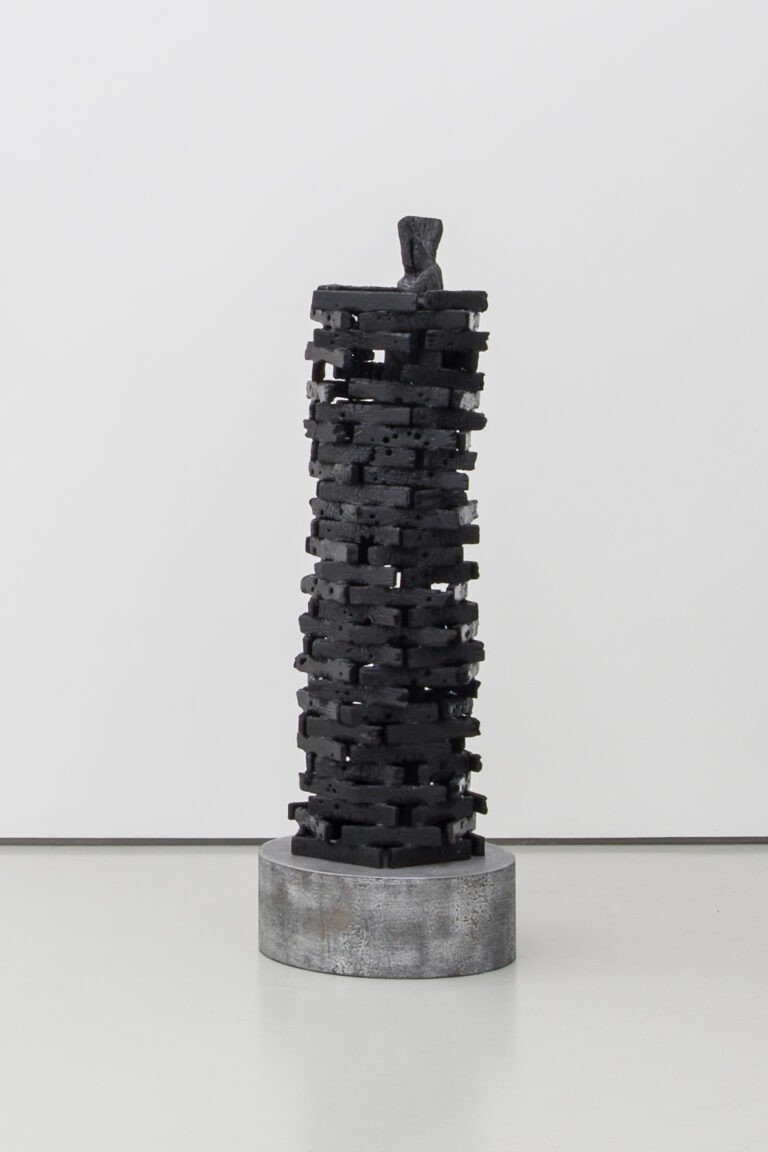
Gereon Krebber, Jengo, 2024, burnt timber, spray paint, wood, 174 x 59 x 59 cm,
courtesy of the artist and alexander levy, Berlin,
photo: Marcus Schneider
In the back room, we encounter the installation Curlyburly: numerous shell-like bodies of glazed ceramic lay on the floor, bulging with worm-like shapes and threatening to brim over. A linear structure of aluminum square tubes with bump-like rivets runs through the work and separates the group.
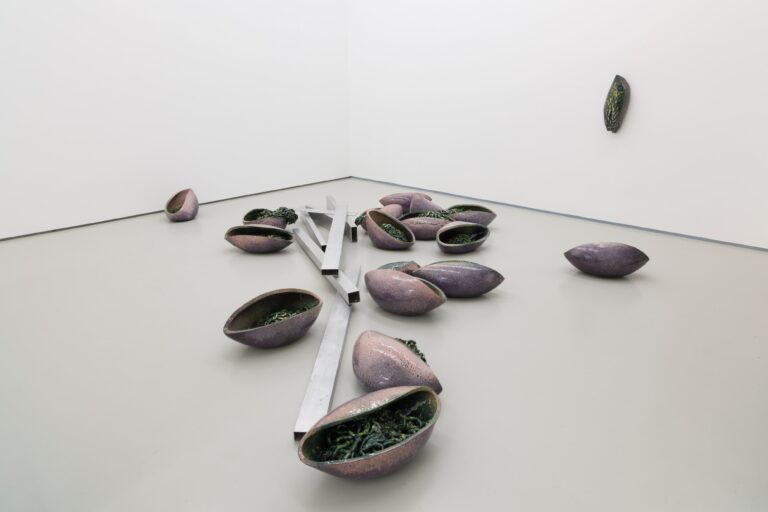
Gereon Krebber, Curlyburly (Smavos), 2023, glazed ceramics, aluminium, dimensions variable,
courtesy of the artist and alexander levy, Berlin,
photo: Marcus Schneider
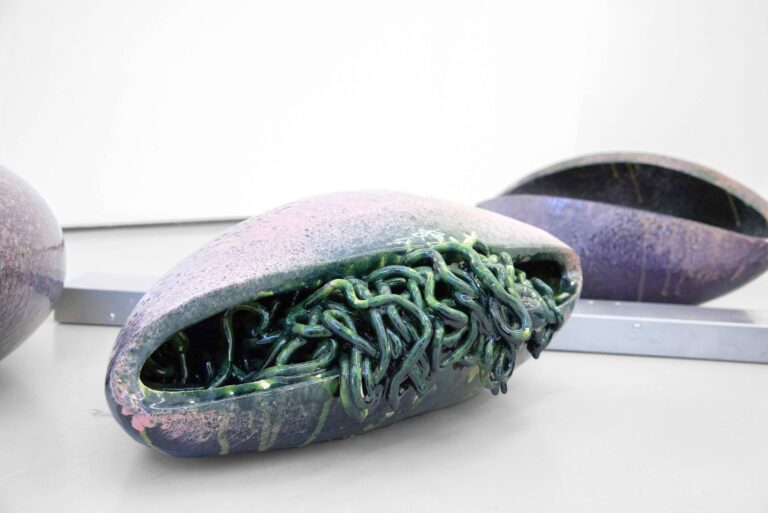
Gereon Krebber, Curlyburly (Smavos), 2023, glazed ceramics, aluminium, dimensions variable,
courtesy of the artist and alexander levy, Berlin,
photo: Marcus Schneider
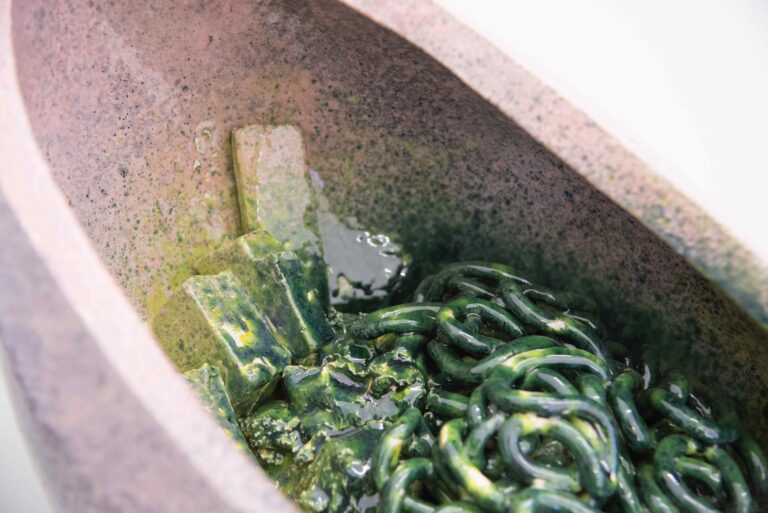
Gereon Krebber, Curlyburly (Smavos), 2023, glazed ceramics, aluminium, dimensions variable,
courtesy of the artist and alexander levy, Berlin,
photo: Marcus Schneider
Krebber creates sculptural momentary images without giving them a complete interpretation or concretization. The meaning only emerges in dialog with the viewers, as they introduce their experiences and associations and thereby impart an additional, intimate dimension to the works. The sculptures question the construction principles of our urban environment, unsettle them and make room for transformation and deformation. It is a play on the fragility and transience of materiality, reflecting not only the external forms but also the internal structures of our society.
